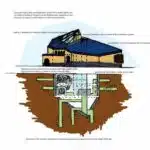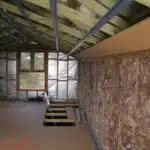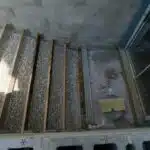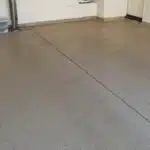A basement is a valuable part of any home, providing extra living space and storage. However, it can be challenging to keep it warm and comfortable, especially during the colder months. A cold basement not only decreases the enjoyment of the space but also causes an increase in energy bills and makes the rest of the house feel cooler. In this article, we will explore nine effective steps on how to make a basement warmer, while also improving its energy efficiency.
One of the essential factors that contribute to a warm and comfortable basement is proper insulation. Insulation helps regulate temperature by trapping heat inside and preventing cold air from entering. Another critical factor is controlling moisture levels as excess moisture can lead to mold growth and cause further damage to your home’s foundation. By following these nine steps, you can transform your chilly basement into a cozy living space while also saving money on energy bills and reducing your carbon footprint.
Assessing Your Basement’s Temperature
Ah, the basement: a space that is often neglected and left to gather dust. But what about its temperature? Have you ever noticed how chilly it can get down there? Fear not! With some simple steps, you can make your basement a cozy and comfortable place to spend time in.
First things first, it’s important to assess your basement’s temperature. This means taking note of how cold it feels down there and using a thermometer to get an accurate reading. But where should you place the thermometer? It’s best to put it in the middle of the room, away from windows, vents, or any other sources of heat or cold air. This will give you an accurate representation of the overall temperature in the space.
Once you have assessed your basement’s temperature, it’s time to identify sources of cold air. These could be anything from drafty windows or doors to gaps around pipes or electrical outlets. By addressing these sources of cold air, you’ll be able to create a warmer environment for yourself and your family. So let’s dive in and start identifying those pesky drafts!
Identifying Sources Of Cold Air
After assessing your basement’s temperature, it’s important to identify sources of cold air in order to make the space warmer. Cold air can enter your basement through various sources such as gaps and cracks in walls, floors, and windows. These drafts can cause significant heat loss, making it difficult to maintain a comfortable temperature.
To identify sources of cold air, start by inspecting the basement for any visible gaps or cracks. Pay close attention to areas around pipes, windows, doors, and electrical outlets. Use a flashlight to help you see into dark corners and crevices. You can also use a candle or incense stick to detect drafts – hold the flame or smoke near potential draft areas and look for any movement.
Once you’ve identified sources of cold air, it’s time to fix them. Depending on the severity of the draft, there are several potential fixes including sealing gaps with caulking or weatherstripping, insulating pipes with foam sleeves or insulation tape, and installing window insulation film or draft stoppers for doors. By addressing these sources of cold air, you can significantly improve the warmth and comfort of your basement while reducing energy costs.
Transitioning into the next section about sealing air leaks: Now that you’ve identified potential fixes for drafts in your basement, it’s time to take action and seal those pesky air leaks once and for all.
Sealing Air Leaks
Imagine trying to fill a bucket that has holes in it – no matter how much water you pour, the bucket will never be full. Similarly, if your basement has air leaks, no matter how much heat you provide, the space will never be warm. These gaps and cracks allow cold air from outside to penetrate your home and warm air from inside to escape. Therefore, sealing these leaks is an essential step towards making your basement warmer.
DIY air sealing is a popular option among homeowners who want to save money on their energy bills. You can use caulk or foam sealant to plug gaps around windows, doors, pipes, and electrical outlets. However, if you are not confident in your abilities or do not have the time and tools required for this task, consider hiring professional air sealing services. A trained technician can identify all the areas of concern and use advanced techniques and equipment for a more effective solution.
Here are some benefits of sealing air leaks in your basement:
- Lower energy bills
- Improved indoor comfort
- Enhanced indoor air quality
- Increased lifespan of HVAC equipment
Now that you understand the importance of sealing air leaks let’s move on to another vital step – adding weatherstripping to doors and windows.
Adding Weatherstripping To Doors And Windows
Weatherstripping is an essential component in making your basement warmer. It involves sealing gaps around doors and windows to prevent cold air from seeping into your living space. DIY weatherstripping techniques can be quite effective, but professional weatherstripping services are also available for those who prefer to have it done by experts.
When it comes to DIY weatherstripping techniques, there are several options you can choose from. One of the most common methods is using adhesive-backed foam tape, which is easy to install and affordable. Another option is using V-strip, which is a flexible plastic or metal strip that can be inserted into gaps around doors or windows. This method requires a bit more effort but provides a more secure seal.
If you prefer to leave the job to the professionals, there are plenty of weatherstripping services available that can help you out. These services typically involve a thorough inspection of your doors and windows followed by installation of high-quality weatherstripping materials. While this option may cost more than doing it yourself, it ensures that the job is done correctly and effectively.
Transition: Now that you’ve sealed all the gaps in your basement with weatherstripping, it’s time to move on to insulating your basement walls for even greater warmth and energy efficiency.
Insulating Your Basement Walls
Imagine walking into your basement on a chilly winter morning and feeling a blast of cold air hit you. This doesn’t have to be your reality if you insulate your basement walls properly. Insulation keeps heat from escaping, which can make your basement feel warmer in the winter and cooler in the summer. There are several insulation techniques that you can use to keep your energy bill low and make your basement more comfortable.
One cost-effective option is to install fiberglass batts between the studs of your basement walls. Fiberglass batts are easy to install and can provide an R-value of up to 15 per inch of thickness, making them an excellent choice for homeowners who want to save money on their energy bills. Another option is spray foam insulation, which provides an air-tight seal that prevents drafts from entering or exiting your home. Spray foam insulation has a higher R-value than fiberglass batts, but it can be more expensive.
If you’re looking for a combination of affordability and efficiency, then rigid foam board insulation might be right for you. Rigid foam board insulation comes in different thicknesses and can provide an R-value of up to 10 per inch of thickness. It’s also easy to install and can be cut to fit any size wall. By using one of these cost-effective options, you’ll not only keep warm air inside but also reduce heating costs significantly.
By insulating your basement walls with one of these three techniques, you will notice a significant difference in how warm and comfortable your space feels throughout the year. However, don’t forget that installing insulated flooring is just as important as insulating walls when it comes to keeping heat in and cold out. Let’s take a closer look at how installing insulated flooring can help keep your space even warmer!
Installing Insulated Flooring
Insulating your basement walls is a crucial step in making your basement warmer. However, it is not the only solution to your home’s insulation needs. Installing insulated flooring is another effective method that can help keep your basement warm. Insulated flooring benefits go beyond just adding warmth to your basement space.
One of the main benefits of insulated flooring is that it helps reduce energy costs. This type of flooring works by trapping air within its layers, which acts as an insulator and prevents heat loss. Additionally, insulated flooring can also provide sound insulation and improve indoor air quality by reducing moisture levels in the room.
When it comes to choosing the right type of insulated flooring for your basement, you have several options available. Some popular choices include cork, bamboo, carpet tiles with padding, and rigid foam panels. Each option has its own unique advantages and disadvantages, so it’s essential to research thoroughly before making a final decision.
Upgrading your HVAC system is another way to make your basement warmer and more energy-efficient. By replacing old or inefficient heating systems with more modern ones that use less energy, you can save money on utility bills while keeping your home comfortable all year round. With proper insulation and heating systems in place, you can enjoy a cozy and inviting basement space that you’ll love spending time in!
Upgrading Your Hvac System
Imagine walking into a cold and drafty house with no sense of warmth or comfort. Just like a person needs a coat to stay warm in winter, your home requires proper insulation and heating equipment to keep the temperature comfortable. Upgrading your HVAC system is essential to ensure that your basement is warm and cozy during the colder months.
One way to improve the efficiency of your HVAC system is by upgrading ductwork. Leaky ducts can result in significant heat loss, which means that you will spend more money on utility bills without getting the desired level of warmth. By sealing any gaps or holes in your ductwork, you can reduce energy consumption and save money on heating costs.
Another effective upgrade is installing programmable thermostats. These devices allow you to control the temperature in your home based on specific times of day or days of the week. You can set them to lower temperatures when you are away from home or sleeping, which reduces energy usage and saves money. With programmable thermostats, you can have full control over your HVAC system without sacrificing comfort.
Upgrading your HVAC system is an investment that pays off in the long run by providing greater comfort, saving energy, and reducing costs. By making these upgrades, you are taking steps towards creating a more energy-efficient home that benefits both yourself and the environment.
Transitioning into using space heaters, there are some situations where they may be necessary for supplemental heat in specific areas of your home. However, it’s important to use caution when selecting and using space heaters as they can pose potential safety hazards if not used properly.
Using Space Heaters
Space heaters can be an effective way to warm up a basement, especially if it is difficult to regulate the temperature using central heating. However, there are pros and cons to using space heaters that should be considered before making a purchase.
Pros of Using Space Heaters: They are portable and can be moved around the basement as needed. They also provide instant heat, which is great for small areas or rooms that need extra warmth. Additionally, some models have energy-saving features that allow you to adjust the temperature and save money on your energy bills.
Cons of Using Space Heaters: They can be expensive to operate if used frequently or for long periods of time. There is also the risk of fire or carbon monoxide poisoning if not used properly. It is important to always follow safety guidelines and never leave a space heater unattended.
If you decide to use a space heater in your basement, it’s important to choose the right brand and model for your needs. Some of the best brands of space heaters for basements include DeLonghi, Lasko, and Honeywell. These brands offer various sizes and features such as adjustable thermostats and safety shut-offs.
Transition into installing radiant floor heating: While space heaters can provide quick relief from a cold basement, they may not be the most efficient long-term solution. Installing radiant floor heating can provide consistent warmth throughout the entire basement without taking up valuable floor space or causing potential safety hazards.
Installing Radiant Floor Heating
Using space heaters can be an effective way to warm up a basement, but it’s not always the most efficient or cost-effective solution. Another option is to install radiant floor heating, which uses hot water or electric coils beneath the flooring to radiate heat upwards into the room. There are pros and cons to this method, as well as best practices for installation.
One of the biggest advantages of radiant floor heating is its ability to provide even, consistent heat throughout a room without relying on forced air ducts or vents. This can be especially beneficial in basements, where heat tends to rise and leave lower areas feeling chilly. Additionally, because the heat source is located closer to the ground, it may feel more comfortable overall since people tend to feel warmer when their feet are warm.
However, there are some downsides to consider as well. Installing radiant floor heating can be expensive and time-consuming, particularly if you’re retrofitting an existing home rather than installing it during new construction. Additionally, if not installed properly, it can lead to uneven heating and higher energy bills. It’s important to follow best practices for installation, such as ensuring proper insulation beneath the flooring and using a thermostat with zoning capabilities.
When it comes to adding area rugs and carpets on top of radiant floor heating, there are some things to keep in mind as well. While these can help add additional warmth and comfort underfoot, they can also trap heat and prevent it from reaching the rest of the room if they’re too thick or dense. It’s best to choose rugs with low pile and avoid those made from materials that don’t conduct heat well (such as certain types of foam). With proper installation and care, however, radiant floor heating combined with area rugs can be an effective way to keep your basement cozy all year long.
Adding Area Rugs And Carpets
Adding area rugs and carpets is an effective way to make your basement warmer. Carpets have insulating properties that can help keep heat from escaping through the floor. This means that less energy is needed to maintain a comfortable temperature in the basement.
One of the benefits of carpets is their ability to trap heat. Carpets and rugs are made of fibers that can hold onto warmth, making them perfect for cold basements. They also provide added comfort by adding cushioning underfoot, which can help reduce foot fatigue.
When choosing the right rug for your basement, it’s important to consider the material and texture. Natural fibers like wool or cotton are great options as they are soft, durable, and have good insulation properties. Synthetic materials like nylon or polyester can also work well as they are easy to clean and maintain. Additionally, choose a rug with a dense pile as it will provide more insulation than a flatweave rug.
To further improve the warmth in your basement, controlling moisture levels is essential. Moisture can create dampness in the air that makes it feel colder than it actually is. In the next section, we will discuss some effective ways to control moisture levels in your basement for a more comfortable living space.
Controlling Moisture Levels
Excess moisture in a basement can lead to a host of problems, including mold growth, musty odors, and even structural damage over time. That’s why preventing moisture from accumulating in the first place is key to making your basement warmer. One effective way to do this is by investing in a dehumidifier. This device removes excess moisture from the air and prevents it from settling on surfaces or seeping into walls.
There are numerous benefits to using a dehumidifier in your basement. Not only does it help prevent mold growth and other moisture-related issues, but it also improves indoor air quality and reduces allergens like dust mites. Additionally, using a dehumidifier can help preserve the integrity of your home’s foundation by preventing water damage over time.
Of course, using a dehumidifier isn’t the only way to prevent excess moisture in your basement. Other techniques include sealing cracks and gaps around windows and doors, improving ventilation with fans or vents, and ensuring that gutters are clean and free-flowing. By combining these strategies with the use of a dehumidifier, you can create a dry, comfortable environment that’s perfect for relaxing or even converting into additional living space.
To further improve the health of your basement foundation before proceeding with other steps such as repairing foundation cracks; you need to ensure that there is no excess moisture present in the area. In this section we have discussed how using a dehumidifier benefits your basement by reducing the risk of mold growth as well as preserving indoor air quality while preventing water damage over time. In addition to these benefits, we have highlighted some moisture prevention techniques that work hand in hand with using a dehumidifier to create an environment suitable for carrying out home improvement projects like repairing foundation cracks without hassle.
Repairing Foundation Cracks
Foundation cracks can be a common problem in older homes and can lead to significant damage if left unaddressed. Repairing these cracks is essential for maintaining the integrity of your home’s foundation, as well as for preventing moisture from seeping into your basement. There are several options available for repairing foundation cracks, ranging from DIY solutions to more costly professional repairs.
If you’re on a budget, then DIY options may be your best bet. The cost of repairing foundation cracks can vary widely depending on the severity of the damage and the type of repair needed. DIY solutions can range from simply filling in small cracks with epoxy or polyurethane sealant to more extensive repairs such as installing carbon fiber straps or steel beams. It is important to note that while DIY solutions may be cheaper, they may not always provide a permanent fix.
For those who don’t have the time or skills to tackle foundation crack repairs themselves, hiring a professional contractor is often necessary. The cost of professional repairs will depend on several factors, including the size and location of the cracks and whether any additional work is required. Professional contractors will typically charge by the hour or by the job, so it’s important to get multiple quotes before making a decision.
- Fill in small cracks with epoxy or polyurethane sealant.
- Install carbon fiber straps or steel beams for more extensive repairs.
- Get multiple quotes from professional contractors before making a decision.
Now that you’ve learned about repairing foundation cracks and considered both DIY options and professional help, it’s time to focus on another key aspect of creating a warm basement: reducing humidity levels by installing a dehumidifier. High humidity levels can make your basement feel damp and uncomfortable, which can ultimately lead to mold growth and other issues. In our next section, we’ll explore how installing a dehumidifier can help keep your basement dry and cozy all year round.
Installing A Dehumidifier
To truly make your basement warmer, installing a dehumidifier is an important step. Not only does it help regulate the humidity levels, but it also has several benefits that can improve your overall indoor air quality. The first benefit of dehumidifiers is their ability to reduce the amount of mold and mildew growth in your basement. This is especially important as mold and mildew can cause respiratory issues and allergies.
Choosing the right dehumidifier model is crucial in making sure that it functions effectively in your basement. The size of the unit should be based on the square footage of the basement, with larger models being ideal for bigger areas. Additionally, consider purchasing a unit with a built-in humidistat to ensure that it maintains optimal humidity levels without overworking itself. Lastly, choose a model with an automatic shutoff feature to prevent overflowing and damage to your flooring.
Incorporating a dehumidifier into your basement heating system will greatly enhance its efficiency by reducing energy consumption. This will ultimately result in cost savings on utility bills. By removing excess moisture from the air, you’ll be able to feel more comfortable while spending time in your basement. With the right model installed, you’ll have peace of mind knowing that you’re taking necessary steps towards ensuring a warm and healthy home environment. Moving forward, let’s explore how adjusting your thermostat settings can further improve energy efficiency in your home.
Adjusting Your Thermostat Settings
Installing a dehumidifier is an essential step in making your basement warmer. However, it is not the only solution to combat the cold temperature down there. The next thing you can do is adjust your thermostat settings.
One option to consider is cranking up the thermostat. While this may seem like a good idea, there are pros and cons to doing so. Pros include that it will quickly increase the temperature in your basement and make it feel warmer. On the other hand, cons include that it will use more energy and result in higher utility bills. Additionally, if you set the temperature too high, it can become uncomfortable and potentially cause health issues.
Another option is to use energy-saving thermostat settings. This includes setting the temperature lower when no one is home or during sleeping hours. By doing so, you’ll save money on your utility bills without sacrificing comfort levels. In addition, some thermostats even have smart technology that learns your habits and adjusts accordingly, saving even more energy over time.
In conclusion, adjusting your thermostat settings can significantly impact the warmth of your basement without breaking the bank on utility bills. Before cranking up the heat, consider the pros and cons of doing so versus utilizing energy-saving settings instead. By finding a balance between comfort and cost-effectiveness with your thermostat settings, you’ll be well on your way to maintaining a warm and cozy basement year-round.
Maintaining Your Basement’s Warmth
After making the necessary changes to your basement, it is important to assess its energy efficiency. This will ensure that you are not only keeping your basement warm but also reducing your energy bills. You can start by checking for any drafts and sealing them with caulk or weatherstripping. Additionally, you may consider replacing old windows and doors with more energy-efficient ones.
Choosing insulation materials is another crucial step in maintaining warmth in your basement. The type of insulation you choose will depend on various factors such as the desired R-value, budget, and moisture levels in the basement. Fiberglass batts, spray foam, and rigid foam boards are some of the most commonly used types of insulation materials.
To further improve the warmth in your basement, you could also consider using a space heater or radiant heating system. However, it is important to note that these methods may increase your energy bills if not used efficiently. Therefore, make sure to use them only when necessary and set them at an optimal temperature.
- Regularly check for drafts and seal them
- Replace old windows and doors with more energy-efficient ones
- Use a space heater or radiant heating system when necessary
Overall, maintaining warmth in your basement requires regular assessment of its energy efficiency and choosing appropriate insulation materials. By taking these steps, you can be assured of a comfortable living space without having to spend too much on energy bills.
Conclusion
Basements can be notoriously difficult to keep warm, but with a little effort and attention, you can transform your chilly space into a cozy retreat. The first step is to assess the temperature of your basement and identify sources of cold air, such as unsealed windows or cracks in the foundation. From there, you can take action by sealing air leaks and adding weatherstripping to doors and windows.
Insulating your basement walls will also help to trap warmth inside. If you notice any foundation cracks, it’s important to repair them promptly to prevent cold air from seeping in. Installing a dehumidifier can also help regulate the humidity levels in your basement, making it feel warmer overall. Finally, adjusting your thermostat settings and maintaining your newly-warm basement will ensure that you continue to enjoy its newfound coziness for years to come.
For example, imagine a family who recently finished their basement renovation but found that it was constantly cold despite turning up the heat. After following these steps and insulating their walls while also repairing foundation cracks they discovered during the renovation process, they noticed a significant change in temperature and were able to comfortably enjoy their new space year-round. With just a few simple updates, anyone can make their basement warmer and more comfortable for everyday use.
Image Credits
- “it’s warmer in the basement” by jillofarttrades (featured)















![How To Clean A Wax Warmer 15 [1425] Wax Moth (Galleria mellonella)](https://green-life.blog/wp-content/uploads/2023/05/TlTgCqusrajq-150x150.jpg.webp)













